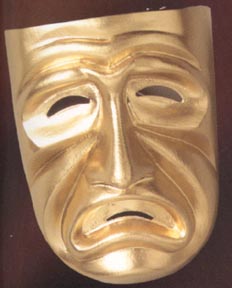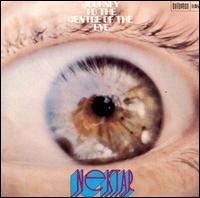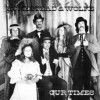
Guy Maddin’s screwball melodrama, “The Saddest Music in the World,” raises an interesting question when probing the unfathomable depths of the broken heart: How sad is too sad? When does sadness stop being a real emotion and become a joke? And where does one draw the line between the truly sad and the patently ridiculous? Maddin’s Vaseline swabbed head-squeezer posits that question and answers with a succession of absurd oddballs vying for the top prize of saddest music-maker in the world, and even offers some resolution when all the despair is finally acknowledged, the sadness felt, the good guys redeemed and the evil burned alive. Can’t stand those ambiguous endings, ya know? “Saddest Music in the World” takes its exaggeration into the stratosphere, beyond it and finally back again, only to reveal that the most somber blows are always born in the family. ‘Course, many have taken their own introspective glances at the frail fabric of familiar relations, but no one’s done it as gleefully and with such lucid abandon as Maddin does in this film. See it all costs.
In honor
of this singular achievement, now available in the sensible DVD format, in no particular order, I give you...
Ten of the Saddest Songs in the World:
1.
Coil “Tainted Love” (from “Scatology” Force and Form CD) – The Soft Cell classic reworked by everyone’s favorite ambitiously gay duo as a dire industrial dirge, complete with Marc Almond himself on uber-sad vocal. An uneasy collision of nightmarish ooze and primitive synth doom informs a track that pulses ever so slowly, and eventually implodes via surging electro swells, sampled choral noises and its own seething discontent. It feels almost like a parody of the original, or is it just a very real attempt at capturing the apocalyptic emotions that accompany any bitter breakup?
2.
Roxy Music “In Every Dream Home a Heartache” (from “For Your Pleasure” Virgin CD) – This is the Roxy song that will convert you if you’ve never been converted. As fine an example of proto goth-EEK art rock as you will find, with Brian Ferry recounting an upscale, spiritually vapid existence with grim detail in vampyric croon. The end result is thought-provoking to the chilled bone, sort of like “Citizen Kane” gone glam in its depiction of dead souled mannequins consuming perfectly mixed martinis, rendered with the slow-burn of ominous foreboding which erupts as one of the most thrilling musical catharses in rock. Ferry describes his nightmare cum reality with the voice of a sardonic insider who can’t stop laughing as he spills his beans. “It’s only a song…it’s only a song…it’s only a song…” Or is it?
3.
Velvet Underground “All Tomorrow’s Parties” (from “Velvet Underground and Nico” Verve CD) – An early classic buoyed on the minimal piano tinkering of John Cale and Nico’s stern delivery. It tells about a girl who today could be a supermodel or one of those Hilton hookers, consumed by her partying lifestyle, and perhaps losing her soul to the night in the process. It’s tragic for sure, not to mention light-years ahead of its time, but damned funny too and just as addictive as the lifestyle it depicts with its wailing wall of distortion and relentless piano strikes, but never does our narrator condemn the protagonist. She even sympathizes, but always with the junkie’s contempt.
4.
Brian Eno “Some of Them are Old” (from “Here Come the Warm Jets” EG CD) – I question whether Mr. Eno himself even knows what this one’s about, but as does all of his material from this period, the song lands squarely in the realm where the surreal comes to shed its tears and the rest of us look on in giddy wonder. Eno charges the everyday with a kind of otherworldly communion where the long dead still converse, flatter and annoy the still living. How to describe this song, other than it opens on a near religious note, segues into a hillbilly wake and then explodes like the sun breaking through the clouds with its final chorale—a kind of sadness engulfed in aural epiphany.
5.
Beach Boys “Surf’s Up” (from “Surf’s Up” Capital CD) – Another ambiguous moment of divine intervention, it works on a similar level as “Some of them are Old,” opening with a sad piano/vocal lament, Brian Wilson intoning cryptic word strings that border on Zen lunacy. Then all that’s left is our mighty hero, paddling in an oceanic expanse where he confronts his Maker and a million, billion stars. The multi-harmony outro is both purifying and sadly nostalgic—a memorial for something lost, but what? God only knows…
6.
Flamin’ Groovies “Teenage Confidential” (from “Shake Some Action” Aim CD) – Later Groovies at their finest in a tear-streaked waltz of musical pathos. The protagonist begs and pleads with his lover not to fold to the lure of gossip and reject his devotion as a result. Yes, this may very well be the very first emo song, but more importantly it’s a mind-blowing rush of pure power pop that both reveals the dire reality of teenage love affairs and the absurd hyper-real drama of it all. Are the ‘Groovies really letting it all hang out in an ace slab of vintage pop heartbreak, or are they just a goofing on all those silly 60s breakup anthems…maybe both?
7.
Nick Drake “Been Smokin’ Too Long” (from “Time of No Reply” Rykomusic CD) – This early gem from the prince of lonely hearts captures him in a rare moment of what could be considered self inflicted cheekiness. It’s a gorgeous down-tempo blues with Drake riffing on his sensitive stoned hipster persona so perfectly realized on “Five Leaves Left” less than a year later. The narrator blasts his love of smoke and substance and resultant bad karma, ultimately damning himself, “ain’t nothin’ gone right with me/ must be I been smokin’ too long.” Granted, it’s an obsession with this kind of self imposed existential doom that would dog Drake to his end, but here he's giving us a wink and saying, “It’s OK to grin and sing along.”
8.
T. Rex “The Slider” (from “The Slider” Polygram CD) – Quintessential Bolan combines his vintage boogy-psych grooviness with obtuse lyrics that, actually, make sense, detailing the bummer life can be and the resultant “slides” that come with, ultimately confirming that nothing nips a bummer in the bud like some good old fashioned chemical rebalancing. Bolan and his band unleash a raw descending blues stomp beat, all manner of voodoo shakers and acid drenched soul harmonies before a beautiful fade of mind-enveloping strings bliss. Sad bliss, though.
9.
Vashti Bunyan “17 Pink Sugar Elephants” (from Ptolemaic Terrascope compilation #? CD) – The golden corded chanteuse recounts the sad scene of the titular goodies, frozen in manufactured complacence--so pretty to see, so vacant to know--in a downcast blues gem that decimates the fragile senses in just under two minutes, and climaxes with the depressing realization that one of the little fellows is merely, “a factory made pink sugar elephant given to children for treats after tea.” Sounds trite, don’t it? It’s more than that though. Bunyan’s mastery of vocal inflection, rhythm and imagery here is about as poetically subversive as any folk poppy ditty from the last 50 years.
10.
Daniel Johnston “Tuna Ketchup” (From “The Early Recordings Vol. 1” Dualtone 2CD) – A later track from DJ’s first self-release captures the sadness of unrequited love with first person recollections of seeing the object of his affections in a parking lot, at a park in the summer; he even goes so far as to “let her walk all over me and insult me too…because I like her.” Ahh, the trials and tribulations we suffer for love. Of course you can’t help but wonder if Daniel ever had the nerve to even talk to her in the first place, and just what does “Tuna Ketchup” have to do with anything?


